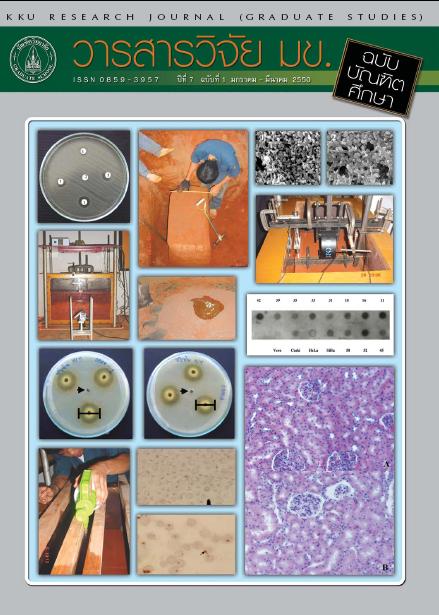An Investigation of Mathematical Ideas in Khon Kaen Tie-Dyed Fabric Silk Process(การศึกษาแนวคิดทางคณิตศาสตร์ในขั้นตอนการผลิตผ้าไหมมัดหมี่จังหวัดขอนแก่น)
Keywords:
Ethenomathematics(คณิตศาสตร์ชาติพันธุ์), Mathematical ideas(แนวคิดทางคณิตศาสตร์), Mathematics and culture(คณิตศาสตร์กับวัฒนธรรม)Abstract
การวิจัยครั้งนี้มีวัตถุประสงค์เพื่อศึกษาแนวคิดทางคณิตศาสตร์ของกลุ่มผู้ทอผ้าไหมมัดหมี่ในขั้นตอน การผลิตผ้าไหมมัดหมี่จังหวัดขอนแก่น เป็นงานวิจัยด้านคณิตศาสตร์ชาติพันธุ์ วรรณา (Ethnomathematics) โดยใช้ระเบียบวิธีวิจัยเชิงคุณภาพที่เน้นการศึกษาภาคสนาม (Field Studies) การเก็บรวบรวมข้อมูลแบ่งเป็น 2 ระยะ ระยะแรกเป็นการศึกษาเอกสาร (Documentary Studies) โดยผู้วิจัยทำการศึกษาเอกสารหลักฐานเพื่อศึกษาความรู้ทั่วไปเกี่ยวกับผ้าไหมมัดหมี่ที่ใช้วิธีการดั้งเดิมในการผลิตของแต่ละท้องถิ่น รวมถึงสภาพภูมิศาสตร์ของพื้นที่ดำเนินการวิจัย ระยะที่ 2 เป็นการศึกษาภาคสนาม (Field Studies) โดยการสังเกตอย่างมีส่วนร่วม (Participatory Observation) ในการผลิตผ้าไหมมัดหมี่เมืองขอนแก่น ของกลุ่มทอผ้าไหม ตำบลเมืองเพีย อำเภอบ้านไผ่ จังหวัดขอนแก่น ซึ่งมีสมาชิกกลุ่มจำนวน 23 คน เป็นระยะเวลา 3 เดือน ตั้งแต่เดือนมิถุนายนถึง สิงหาคม 2548 และทำการสัมภาษณ์เชิงลึก (Indepth Interview) ในประเด็นที่สื่อถึงแนวคิดทางคณิตศาสตร์ในขั้นตอนการผลิตผ้าไหมมัดหมี่ และทำการสัมภาษณ์ภายหลังจาก เสร็จสิ้นในแต่ละขั้นตอนของการผลิตผ้าไหมมัดหมี่นำข้อมูลที่ได้จากศึกษาภาคสนามทั้งในส่วนของการสังเกตอย่างมีส่วนร่วม และการสัมภาษณ์ ประกอบกับข้อมูลที่ได้จากการศึกษาเอกสาร มาตรวจสอบความถูกต้อง และความสมบูรณ์ของข้อมูลด้วยวิธีการแบบสามเส้า (Triangulation) การวิเคราะห์ข้อมูลใช้การวิเคราะห์ตามกรอบแนวคิดที่ใช้พิจารณาแนวคิดทางคณิตศาสตร์ในขั้นตอนการผลิตผ้าไหมมัดหมี่จังหวัดขอนแก่น ที่ผู้วิจัยได้ผนวกขั้นตอนการผลิตผ้าไหมมัดหมี่จังหวัดขอนแก่น ของสภาวัฒธรรมจังหวัดขอนแก่น (2542) 4 ขั้นตอน ได้แก่ การเตรียมเส้นไหม การมัดหมี่ การเตรียมเส้นเครือ (เส้นยืน) และการทอผ้าไหมมัดหมี่ กับแนวคิดเชิงทฤษฎีของ Bishop (1988) ที่พิจารณาแนวคิดทางคณิตศาสตร์ของกลุ่มชนต่างๆ จากกิจกรรมทางคณิตศาสตร์ ได้แก่ การนับ (Counting) การกำหนดขอบเขต (Locating) การวัด (Measuring) การออกแบบ (Designing) การละเล่น (Playing) และการอธิบายชี้แจง (Explaining)
จากการวิจัยพบว่า แนวคิดทางคณิตศาสตร์ที่เกิดขึ้นในขั้นตอนการผลิตผ้าไหมมัดหมี่จังหวัดขอนแก่น มีดังนี้ 1. กิจกรรมการนับ (Counting) แสดงให้เห็นถึงแนวคิดเกี่ยวกับการใช้คำลักษณะนาม (Classifier) ได้แก่ ด้ง ปอย เที๊ยะ ขีน ลำ ควม และหลบ การใช้สัญลักษณ์แทนการนับ ได้แก่ การไพไหม ขีนหมี่ (การไขว้กันของเส้นไหม) และการใช้เชือกวางพาดบนเส้นไหม การใช้สัญญาณเสียงเป็นจังหวะในการนับจำนวนรอบในการค้นไหม และการดำเนินการนับจำนวนรอยบากบนขาค้นหมี่ 2. กิจกรรมการกำหนดขอบเขต (Locating) แสดงให้เห็นถึงการมีแนวคิดเกี่ยวกับการกำหนดสัญลักษณ์เพื่อระบุตำแหน่ง ได้แก่ การทำบ้วง (ขมวดปลายเส้นไหม) การใช้สัญลักษณ์ในการกำหนดขอบเขต ได้แก่ การใช้กระดาษกาวติดบนขาค้นหมี่ในการกำหนดลำหมี่ การใช้กระดาษตารางเพื่อจำลองโครงสร้างในการออกแบบลาย การหาความสัมพันธ์ของจำนวนขีนหมี่และจำนวนลำหมี่สำหรับผ้าไหม 1 ผืน และการลำดับก่อนหลัง ได้แก่ การร้อยหลอดหมี่ตามลำดับก่อนหลัง และการทำให้เส้นไหมไขว้กันในการค้นเครือหูก 3. กิจกรรมการวัด (Measuring) แสดงให้เห็นถึงการมีแนวคิดเกี่ยวกับ การนับจำนวนวัตถุดิบให้เท่ากัน ได้แก่การกำหนดจำนวนรังไหมที่จะทำการดึงเส้นใยในแต่ละวัน เทคนิควิธี การวัด ได้แก่ การวัดอุณหภูมิในการต้ม รังไหม การใช้ไม้ดันลายหมี่ในการมัดหมี่ และการแทก การประมาณ ได้แก่ การคะเนรังไหมที่ใช้ต้มแต่ละครั้ง มาตราวัด ได้แก่ มาตราวัดความยาวเส้นไหม การกำหนดสัดส่วน ได้แก่ การด่องไหม และการย้อมสีเส้นไหม และการกำหนดจุดเริ่มต้นจุดสิ้นสุดในการปั่นหลอดเพื่อให้หลอดหมี่แต่ละหลอดมีขนาดเท่ากัน 4. กิจกรรมการออกแบบ (Designing) แสดงให้เห็นถึงการมีแนวคิดเกี่ยวกับการกระทำเพื่อให้เป็นผลต่อรูปร่างวัตถุ ได้แก่ การเกี้ยวเส้นไหมในการสาวไหม การใช้จินตนาการเพื่อวาดโครงสร้างในการออกแบบลาย แบบรูป (Pattern) ได้แก่ วิธีการมัดหมี่ วิธีการถักเปียเส้นเครือ และวิธีการสืบหูก และการขยายรูปร่าง ได้แก่ การสอด 4 ลวง 1 5. กิจกรรมการอธิบายชี้แจง (Explaining) แสดงให้เห็นถึงการมีแนวคิดเกี่ยวกับการสมมาตรในการให้เหตุผลของการค้นลำหมี่เป็นเลขคี่ และความสัมพันธ์ของตัวเลข ได้แก่ การค้นลำหมี่ที่ต้องมีความสัมพันธ์ของจำนวนขีนหมี่และจำนวนลำหมี่เพื่อให้ได้ผ้าไหมที่มีขนาด 1 ผืนเท่าเดิม
The objective of this research was to investigate mathematical ideas in the process of producing Khon Kaen tie-dyed fabric silk. This is the research of ethnomathematics by using qualitative analysis method, emphasizes to the field studies. There were two phases to collect data for analysis. The first phase was the documentary studies. Researcher studied through documents of the methods in the process of producing tie-dyed fabric silk of each district as well as the geography. The second phase was the field studies, the researcher made a participatory observation to a group of silk workers (23 persons) in Muang Pear subdistrict, Banphai district, Khon Kaen province for three months (June-August 2005). Subsequently, the researcher made an indepth interview of each worker while they were working and after they finished each of four procedures (i.e., preparing fabric, making tie-dyed fabric, preparing the fabric to be determined the length of silk, weaving). Based on Bishop.s (1988) framework on 6 mathematical activities of human activities, data from transcriptions of the interview session and field notes from the observation session were used to clarify mathematical ideas embodied in activities of making tie-dyed fabric silk. Afterward, the collected data was examined with the triangulation method and was analyzed with the mathematical ideas in the process of producing Khon Kaen tie-dyed fabric silk. Results of the research: The mathematical ideas occurred in the process of producing Khon Kaen tie-dyed fabric silk are shown as following; 1. Counting It demonstrated the use of the classifier, (i.e., Dung (duη), Poy [p∂∂j], Tia [tía], Kheen [khìin], Lum [làm], Kuom [khúam] and Lop [lóp]). Moreover, the symbols was used instead of counting (i.e., Paimai [pàjmàj] (using the rope to tie around the string of silk), Kheenmee [khìinmìi] (the cross Poy, Tia, Keen, Lum and Lop. Moreover, there was n complicated than inm \Åã√π.\ πÅã √ in ed of the silk) and put the rope on the string of silk), using the voice signal to be the rhythm to count of the round of Lummee [làmmìi] (group of silk string) and the process of counting the cross on the Lummee setting tool. 2. Locating It demonstrated the idea of setting a symbol in order to specify the position such as Buang [bùaη] (to knit on the end of silk string), using symbols in order to set the limitation, which were the using of paper table in order to be in image of the design, finding the relation of the amount of Kheenmee [khìinmìi] and Lum [làm] in a piece of silk, the priority such as to string the silk tube according to the priority and to cross the silk string in order to specify the length of the silk. 3. Measuring It demonstrated the idea of counting material (i.e., to specify the amount of silk pods which were used each day), technique in measuring such as measuring the temperature in boiling silk pod, the using of the rod in Mudmee [màtmìi] and inserting the pattern (measuring the pattern), the estimation such as the estimation silk pod for each time of boiling. The measuring system are length measurement, the proportion such as Dongmai [d∂ηmàj] (bleach) and yarn dye and specify the beginning and ending of throwing. 4. Designing It demonstrated the idea of action that affected to the figure of the object (i.e., Kiew [kíaw] (to cross the silk string)), the using of imagination to design, the pattern such as Mudmee, maintain the warp, continuing the silk string and the expand the figure which was Sod [s∂∂t] 4 Luong [lùaη] 1 (dash the silk string that had pattern 4 times and another silk string 1 time). 5. Explaining It demonstrated the idea of the symmetry in specification of Lummee [làmmìi] to be an odd number and the relation between the number of Lummee [làmmìi] and Kheenmee [khìinmìi] in order to get 1 piece of silk.



